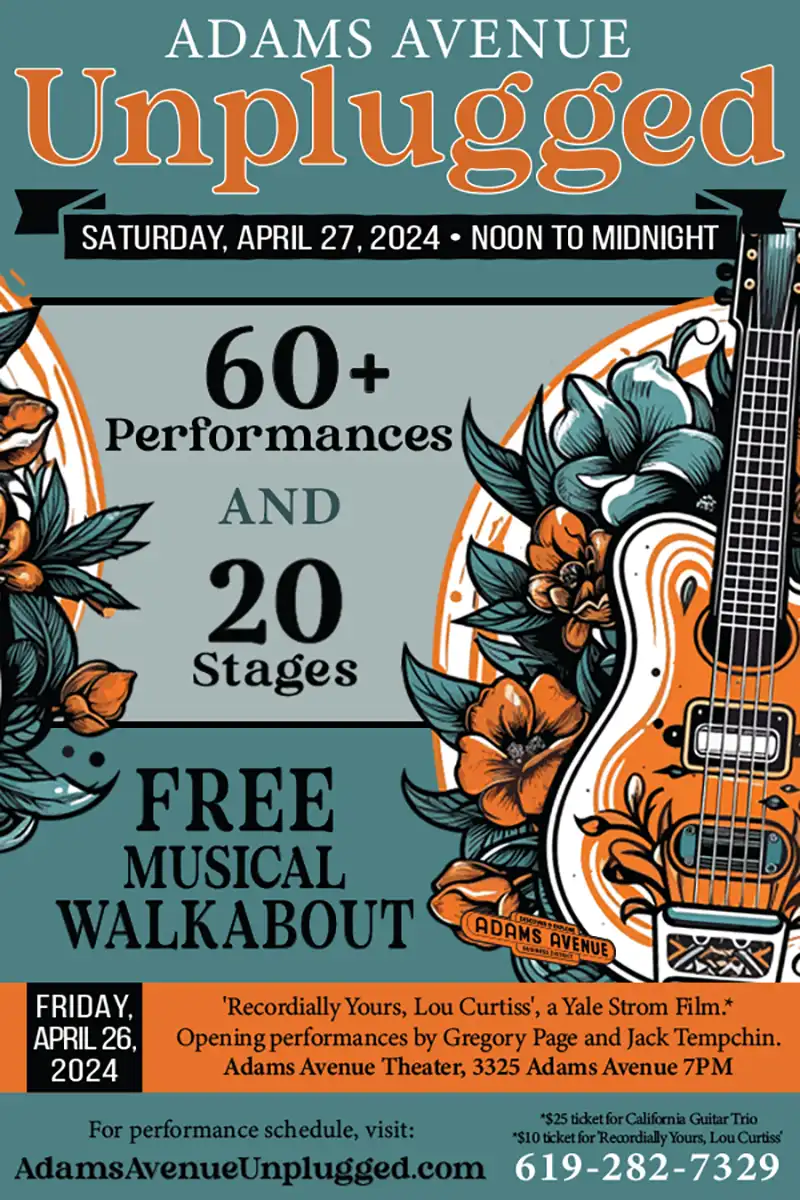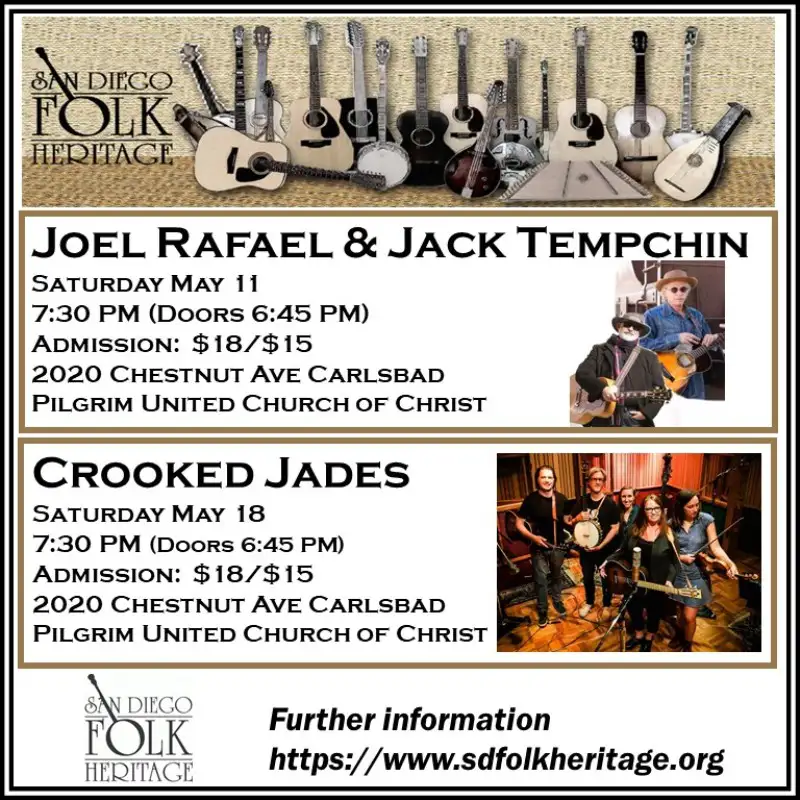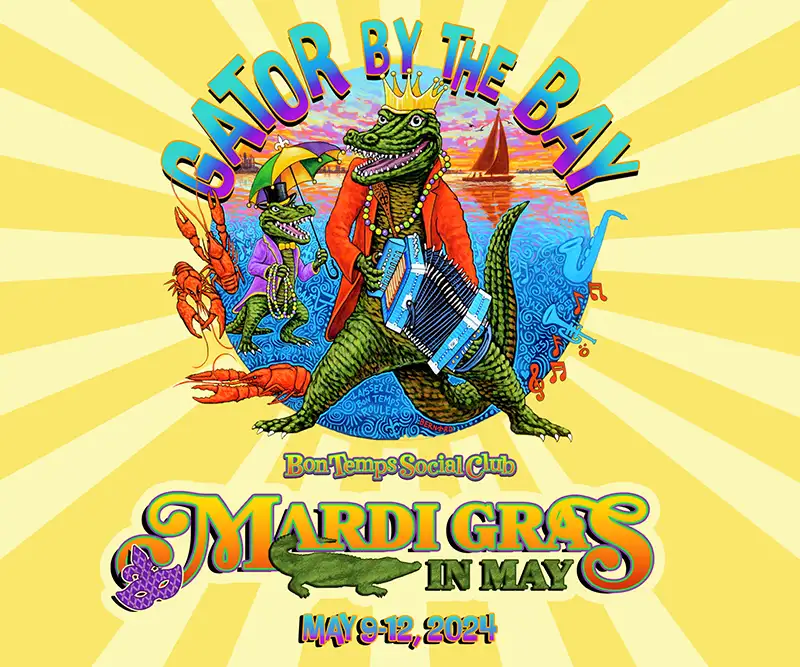Featured Stories
One Man’s Journey to Find His Tribe
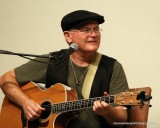
Joe Rathburn. Photo by Dennis Andersen
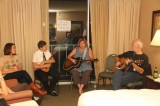
Lindsay White and Veronica May (left) at the Folk Alliance this year.
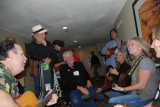
Folk Alliance impromptu jam in the hotel.
Way back when I was maybe eight years old, living in lower rural Michigan, and my 18-year-old brother brought home a 12-string guitar (“The only one in Flint.” he proudly told me.) I had an inkling of what I wanted to do with my life and that was to play guitar. But not rock and roll. The Beatles hadn’t yet hit our shores and the Great Folk Scare of the late fifties and early sixties was still upon us. My brother was listening to the more commercial product spun off of that fad. The Limelighters, Harry Belafonte, the Chad Mitchell Trio, Peter, Paul and Mary, Burl Ives, and the like were more his speed, and I liked that sound. My next door neighbor, who was my age, played guitar too but was into Chet Atkins, and he wasn’t for me then. I hadn’t yet heard the more raw and authentic music of the likes of Woody Guthrie, Josh White, Leadbelly, Cisco Houston, the Weavers, John Jacob Niles, or Odetta, and even later, when I had heard them, I still gravitated toward the slicker, more commercial sounds of the folk era. I believe, however, that was more due to the better production values than the actual music.
Sure, I’d sung Woody Guthrie’s “This Land Is Your Land” at assemblies at school — everybody had, but I didn’t know who he was. He hadn’t grabbed my attention as a star to hook my wagon to. A young upstart from Hibbing, Minnesota named Bob Dylan, who I wouldn’t notice until much later in life, had hooked his wagon firmly to Woody’s star, which sling shot him into a career that would go on to change how we all listened to and wrote music.
It wasn’t until 1965 (age 11) when I saw Simon and Garfunkel on “American Bandstand” one Saturday afternoon that I was truly hooked on making a living with a guitar. Not even the Beatles on “The Ed Sullivan Show” had as great an effect on me, though of course I wasn’t totally immune to their music’s charms.
I’d always been drawn to folk music. It’s not that I immersed myself in it; on the contrary. I developed very eclectic tastes in popular music and listened to and played everything from Mose Allison to Led Zepplin, but something about the simple beauty of a not too overly produced folk recording always appealed to my ear. I usually preferred a single guitar and voice to a stage full of amplification.
I first heard of the North American Folk Music and Dance Alliance in 1996 while working on my first big budget solo recording, Little Suns (which came out, ironically enough, too overly produced for most folk music fans). Folk Alliance (for short) was an organization whose mandate was to propagate all things having to do with folk music and dance, and they held an annual conference. I was told it was the place to go to get noticed in the folk music world. Not really considering myself a folk musician, but not really fitting into pop or rock, the mainly acoustic sound of my record helped me make up my mind to get to that year’s conference in Nashville and see what would happen.
What happened was that I found a wonderful world where somewhere between 1,500 and 2,000 kindred spirits, all of whom made their living in one way or another from folk music, converged on (took over) a hotel for three amazing days and nights, making every conceivable space ring with the joyous sounds of voices, guitars, banjos, fiddles, harmonicas, and all sorts of other instruments. This, I truly felt, though I may not have been a full-blooded member, was my tribe.
I’ve attended four national conferences; that first one in Nashville, then Memphis, Jacksonville, and finally here in San Diego. Each one was a thrill-a-minute ride that paid off, if not in direct financial remuneration, in years’ worth of contacts, knowledge, and inspiration. At one of them, which occurred right as we, the USA, were preparing to invade Iraq, with testimony on all the TVs about the weapons of mass destruction, a spontaneous peace rally broke out right there in the great lobby of the hotel. Hundreds of us were gathered there singing peace songs, chanting slogans, listening to speeches, and generally feeling like (here’s that word again) a tribe. Though I grew up in the ’60s, I was kept insulated from that aspect of the era. Here was a little slice of what I had missed. It was certainly interesting.
Those big national conferences, however, can be a bit daunting to one such as me who really hasn’t garnered a big name for himself on a national level. So enter the regional conference. Folk Alliance International, as the organization is now called, has been subdivided into five regions, each holding their own conference in their respective part of the country. SWRFA (Southwest Regional Folk Alliance), FARM (Folk Alliance Region Midwest), SERFA (Southeast Regional Folk Alliance), NERFA (Northeast Regional Folk Alliance), and finally FAR-West (or Folk Alliance Region-West). I’ve attended three FAR-West conferences: one in Mesa, Arizona, one in Irvine, CA, and this year’s in Eugene, Oregon, where there were approximately 350 in attendance. Let me tell you a bit about this year’s.
I’d never been north of San Francisco before I drove myself up to Eugene. Oregon is just as green and beautiful as I’ve always heard it was. The weather was perfect for this mid-October conference. The leaves were in full autumn color and there was a slight crispness in the air in the mornings, though I rarely had to wear a jacket. The conference was split between two venues (usually it’s contained in the one hotel). The Eugene Hilton was the conference hotel and the site of the Saturday awards banquet and the private guerilla showcases (or PG showcases. More about those later.); the John G. Shedd Institute for the Arts was the site of all the other music-related events, panel discussions, and workshops, as well as the exhibit hall.
Most conference attendees stayed at the Hilton, but I checked into a nice little place called the Campus Inn (Eugene, of course, being a college town and home of the Ducks). To my delight the Campus Inn was just across the street from the Shedd, very convenient for catching most of the conference action, but not so much for getting to the Hilton, three blocks and change away, for those PG showcases I mentioned earlier. Let’s talk about those.
Part of the reason folkies like me attend this shindig is to try to get noticed. There are numerous ways this can be accomplished. The two main ones are to either secure a sanctioned showcase slot for which you must audition, or book yourself a few PG slots. Those take place in hotel sleeping rooms. The host of the room rearranges the furniture to accommodate both the performers and the audience (which sometimes grows to as many as 20 or 30 in the larger suites), puts out some snacks, decorates the room to personalize the experience, and opens the door to all comers who wish to check out the featured artists. The hope is that a “presenter” (someone who might contract a performer for a show sometime in the future) will pass through said door and be swept off their feet by one of the totally unplugged sets. These showcases begin at 10:30pm (after the sanctioned concerts have taken place) and officially end at 2:30am, but often continue until daylight. The conference reserves two floors. One is for music only, and one for sleeping so as not to interfere with any non conference guests. One attendee quipped that the Folk Alliance should change their name to Occupy Hiltons.
This year I had booked only three PG showcases, one each night. This allowed me time to catch other showcases and socialize, make connections, and see old friends. I also had a sanctioned in-the-round showcase with two other acts. None of these opportunities garnered me any immediate bookings, but that’s not the whole point. Just having one’s name in the program is worth the price of admission.
This year was no different than previous conferences as I discovered several artists that were remarkably good and worthy of mention: Chi McClean, a young man from San Francisco had a remarkably soulful voice and played guitar masterfully, Sourdough Slim and Robert Armstrong blew me away with their amazingly polished yodeling cowboy/vaudeville act, Teresa Tudury was a cross between Bonnie Raitt and Marlene Dietrich, Jim Page was absolutely an evolved progression of 1964 vintage Dylan who decided not to go electric, and Jude Johnstone, a female Randy Newman though with more commercial potential.
There were too many more great artists there to mention, some new to me and some old friends. There were at least two other San Diego based acts there as well, both duos: the ever popular Berkley Hart, and the up-and-coming Love Birds who actually scored a sanctioned showcase. Congrats to them.
In the future I will try and catch that tribe vibe whenever possible, and if you get a chance, sign up and experience it yourself. You can join Folk Alliance International or read more about it at http://www.folkalliance.org/.


